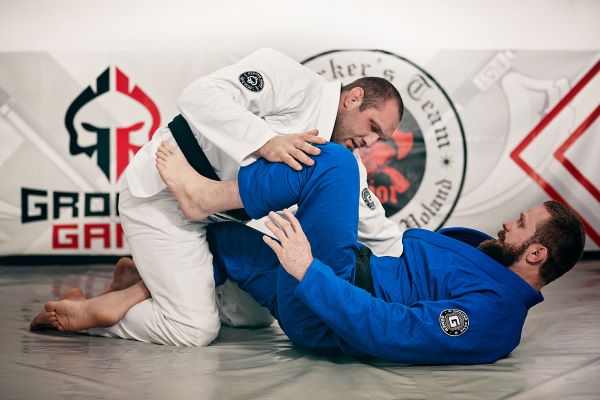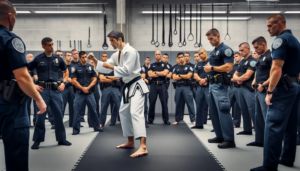
Are you wondering what a gi in martial arts is?
In this article, we’ll look at what a martial arts gi is, the materials used in different gi’s, which martial arts use a gi, why martial artists wear a gi, what the different gi colors mean, and more.
Contents
What Is a Gi in Martial Arts?
A martial arts gi, also known as a dōgi, or Keikogi, is a traditional uniform consisting of a jacket and trousers, traditionally worn when training in Japanese martial arts but now also worn in many non-Japanese martial arts.
A martial arts gi comes in two parts, the upper jacket known as the uwagi, and the trousers known as shitabaki (underpants) or zubon (trousers).
The martial arts gi was created around 1900 by Kanō Jigorō, the founder of Judo. Gi is a shortened version of Keikogi, where Keiko means practice and gi means dress or clothes (practice clothes).
Kanō Jigorō created a gi because normal clothes weren’t fit for the purpose of judo. He needed an official training uniform that wouldn’t rip during intense grappling, allowed for a full range of motion, and the ability to train and execute all grappling and throwing techniques.
Why Do Martial Artists Wear a Gi?
Martial artists wear a gi for the following reasons:
- Practicality – gi’s are comfortable, provide safety, and can withstand the intensity of grappling without ripping – they’re fit for purpose.
- Retaining the history and integrity of martial art – when most gi’s were made, they resembled local clothing or some part of a culture. In time, modifications were made to best suit training, but styles and resemblances have remained for the remembrance of history and culture.
- Focus – wearing a practical uniform tells martial artists it’s time to focus 100% on training. Martial artists feel prideful in a gi, which further sharpens focus and dedication to training.
- Identification – gi’s allow everyone to identify one another in terms of who’s training and the different ranks and positions (teacher or student).
- Commonality – gi’s promote a commonality, unity, and a sense of community among martial artists.
What Materials Are Martial Art Gi’s Made Of?
Martial art gi’s are made of 100% cotton or a 55% cotton and 45% polyester blend, but sometimes the percentages can be slightly different. The fabric of a Martial art gi weighs 350 grams/m2 (grams per square meter) to 1050 grams/m2, which refers to their density.
Poly-cotton gi’s are mostly light to medium in weight, while 100% cotton is medium to heavy. Poly-cotton gi’s are preferred for training as they’re lighter, more breathable, and less likely to shrink when washed.
100% cotton gi’s are mostly used during formal demonstrations and competitions because they’re heavy-duty and usually the most expensive.
100% cotton gi’s are also used less because they’re more likely to shrink, so they must be washed in cold water and air-dried.
Martial arts gi’s are also differentiated by variations of weave, which determines a gi’s weight, comfort, and durability. There are 6 main weave variations, which are:
1. Single Weave
Single weave gi’s are made of the lightest material, meaning they’re a poly-cotton blend and weigh between 300-550 grams/m2.
Single weave gi’s are best in the hottest conditions due to being lightweight and loosely woven. Single-weave gi’s are ideal for beginners as they tend to be the cheapest gi available, due to being the most cost-effective to bulk manufacture.
Single weave gi’s are best suited to martial arts which don’t have a lot of grappling and throwing such as taekwondo, as they’re the thinnest martial art gi and most likely to rip.
Also, as single weaves are lighter and thinner they’re easier to grip and control, which isn’t recommended for use in grappling heavy competitions like judo or Bjj as it’s a disadvantage.
Single weave gi’s may be preferred in competition when a competitor is close to the weight limit and needs a lighter gi.
2. Double Weave
Double weave gi’s are made from 100% cotton and are the thickest martial art gi. This makes them ideal in colder conditions as they provide more warmth.
Double-weave gi’s are best suited to experienced and committed martial artists as they’re the most expensive gi on average.
They’re also ideal for martial arts which include lots of grabbing and throwing such as judo, as the thicker material and heavier weight make them very durable and less likely to rip.
Double-weave gi’s are best for competition as their durability means they can withstand intense wear and the thicker material makes it harder for opponents to get a good grip.
However, a competitor won’t want a double weave gi if they’re close to their weight limit as they’re the heaviest gi.
Depending on the person, double weave gi’s may not be worn when training, because they can be the most abrasive and irritating to the skin – and as time spent training is always the highest, comfort is essential.
3. Gold Weave
Gold-weave gi’s have a thickness between a single and double weave gi, making them ideal for cool conditions.
They have the lightness of a single weave gi and the durability of a double-weave and often weigh between 650-1050 grams/m2.
Gold weave gi’s were once required when competing (Bjj) in Brazil, as per the Brazilian Jiu-Jitsu Federation.
However, since the IBJJF started to allow other gi’s to be used, the gold weave is hardly used anymore.
Gold weaves are also used less today (2023) because they’re the gi most likely to shrink.
4. Platinum Weave
Platinum weave gi has a thickness between gold and single weave and is best suited to training in hot conditions and martial arts which require more thickness than a single weave gi offers.
5. Pearl Weave
Pearl-weave gi’s are tightly woven and recognized by the rows of bumps that look like pearls. Pearl-weave gi’s are the most popular for Bjj today because they’re light, durable, and less likely to shrink than others. They’re also the lightest gi allowed in Bjj competition.
As they’re ideal for use in training and competition, martial artists can purchase just one pearl weave gi if money is an issue.
Pearl weave gi’s have become much more popular than single weave gi’s because they’re similar in price and less likely to tear.
6. Ripstop Weave
Ripstop weaves are commonly a poly-cotton blend and sometimes they use nylon – but they can also be 100% cotton.
As the name suggests, ripstop weaves are woven in a way that prevents rips and tears in the gi, which makes them ideal for intense training.
Ripstop weave gi’s are also especially light, comfortable, and well suited to hot conditions.
However, ripstop weave gi’s have less stretch and are a tighter fit than other weaves, but they’re still comfortable and allow for a full range of motion.
Ripstop weave jackets aren’t legal (ripstop pants are legal) under IBJFF rules as they’re very thin and hard to grip, so they can’t be used when competing.
Make sure to check ripstop weave gi’s are allowed to be used in competition with your relevant leading federation before making a purchase.
Which Martial Arts Use a Gi?
In 2023, many martial arts use a gi and they each have a unique name for the gi they use. The names are:
- Judo: Judogi
- Brazilian jiu-jitsu (Bjj): Brazilian jiu-jitsu gi
- Japanese jiu-jitsu (traditional): Jujutsugi
- Karate: Karategi
- Sambo (Russian): Sambovka/Kurtka
- Aikido: Aikidogi
- Taekwondo and Hapkido (Korean martial arts): Dobok
- Kendo: Kendogi
- Vovinam (Vietnamese): Võ phục
What Do the Different Gi Colors Mean?
Martial arts gi colors have no particular meaning but are used for the identification of teachers and students in training, or to distinguish martial artists during competition.
Martial arts gi’s come in three main colors, white, blue, and black, and the use of each varies among each martial art.
Traditionally, white was the first (and still is) primary gi color used in judo and other Japanese martial arts because they see white as the symbol of spiritual and physical purity.
This dates back to when Japanese Emperors wore white clothing during Shinto rituals – a purification process.
It wasn’t until 1997 when judo competitions became popularized that blue gi’s were introduced alongside white gi’s to distinguish two opposing competitors. Blue gi’s are now used for this purpose in judo, Bjj, and sambo.
In 2023, blue and white judogis are still the only allowed colors in judo competitions under the rules of the International Judo Federation.
In Bjj, black is also allowed alongside white and blue gi’s, as per the International Brazilian Jiu Jitsu Federation (IBJFF).
When not in formal Bjj competition, practitioners can wear a Bjj gi of almost any color depending on personal preference, green, pink, red, or gray.
Some Bjj schools don’t allow too many colors to be used and have rules regarding what colors are allowed – but most are lenient when training and not in competition.
In karate, white is the traditional karategi color and the only color allowed in karate competitions as per the World Karate Federation. Competitors are distinguished by the color of gloves and belt, which is red and blue.
Even in training, most karate schools have a white-only karategi policy, while a small percentage allows other colors, mainly black.
Some karate schools may use a different color gi such as red or black for teachers/instructors and white for students.
Overall, the colors used and their meaning depend on the karate school.
However, American karate derivatives such as kenpo karate are much more lenient on gi colors used in training and may include blue, green, black, and even pink.
Again, the gi colors used vary from kenpo school to school, where many schools have instructors in black and students in white.
In sambo, competitors use red and blue colored gi’s. They use red because it’s Russia’s national and traditional color, and blue because judo started to use blue in competitions, of which sambo is a derivative.
The traditional color of a taekwondo dobok is white, which can also come with black trim, and black doboks are now also commonly used.
High-ranking taekwondo practitioners of 7th dan and above wear yellow jackets with black trousers.
The color of the taekwondo dobok is often determined by the rules of each school. Like many other martial arts, black doboks may be worn by teachers and white by students, as a way to distinguish the two.
Taekwondo practitioners are also distinguished by the color of the lapel on the jacket and the color of the trousers. In competition, the only allowed dobok color is white.
What To Wear Under a Gi
While martial artists can wear clothes under a gi in training, some competitions don’t allow clothes to be worn under a gi so make sure to check with the relevant governing body for your martial art.
For example, under the IBJFF rules, clothing under a gi is prohibited in competition, except for women who can wear elastic fabric clothing shorter than their gi jacket and trousers.
Wearing clothes under a gi is common when training in cold conditions, dirty environments (gyms/dojos), and in martial arts performing many throws (judo) or having lots of ground grappling (Bjj).
Common clothing worn under a gi is underwear, a t-shirt, and shorts, but more protective are rash guards for the upper body and spats or compression shorts for the legs.
These protect the skin from burns, scratches, and bacterial infections such as staph – a potentially deadly infection common among martial artists.
Rash guards are also moisture-wicking, so they prevent the gi from becoming wet, abrasive to the skin, and hard to grip, and they also have anti-odor technology.
Here’s one of the most popular rash guards on Amazon for good reason. It’s affordable, great quality, and multi-purpose as it can be used under a gi in every martial art and also used for other sports like swimming.
Some martial artists complain spats can restrict their movement, but they’re great protection. Instead, many martial artists opt for compression shorts under their gi as this allows them to also wear a cup for groin protection.
Here’s one of the most great-quality and popular compression shorts with a cup at an affordable price.
If you want premium quality and aren’t concerned with price, then the Diamond MMA Compression Shorts are perfect to wear under a gi.
The Bottom Line
So, ‘what is a gi in martial arts?’
A martial arts gi is a traditional uniform consisting of a jacket and trousers, traditionally worn when training in Japanese martial arts but now also worn in many non-Japanese martial arts.




